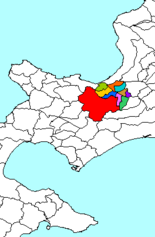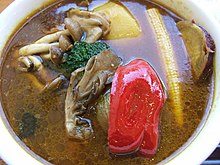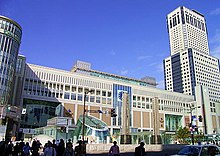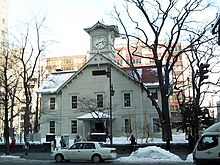Sapporo: Difference between revisions
→Modern History (20th century): repleced WWII → Second Sino-Japanese War as reason of a 1938 event; other minor modifications |
No edit summary |
||
| Line 1: | Line 1: | ||
--[[Special:Contributions/216.56.21.254|216.56.21.254]] ([[User talk:216.56.21.254|talk]]) 20:28, 4 March 2008 (UTC){{Infobox City Japan |
|||
{{Infobox City Japan |
|||
|Name= Sapporo |
|Name= Sapporo |
||
PIZZAAAAA is PURPLE! meow? |
|||
|JapaneseName= 札幌市 |
|JapaneseName= 札幌市 |
||
|MapImage= The Location Sapporo.png |
|MapImage= The Location Sapporo.png |
||
Revision as of 20:28, 4 March 2008
--216.56.21.254 (talk) 20:28, 4 March 2008 (UTC)Template:Infobox City Japan


Sapporo (札幌市, Sapporo-shi) is the fifth-largest city in Japan by population and the third-largest by geographic area. It is the capital of Hokkaidō Prefecture, located in Ishikari Subprefecture, and an ordinance-designated city of Japan.
Sapporo is best known outside Japan for hosting the 1972 Winter Olympics, and the annual Yuki Matsuri in the city, internationally referred to as the Sapporo Snow Festival, which draws more than 2 million tourists from around the world. The city is also home to the eponymous Sapporo Breweries.
History
Early history
Prior to its establishment, the area occupied by Sapporo (known as the Ishikari Plain) was home to a number of indigenous Ainu settlements. In 1866 at the end of the Edo Period construction began on a canal through the area, encouraging a number of early settlers to establish Sapporo village.[1] The settlement's name was taken from the Ainu language, and can be translated as "large river running through a plain".
In 1868 (the officially recognised year celebrated as the 'birth' of Sapporo), the new Meiji government concluded that the existing administrative center of Hokkaidō, which at the time was the port of Hakodate, was in an unsuitable location for defense and further development of the island. As a result it was determined that a new capital on the Ishikari Plain should be established. The plain itself provided an unusually large expanse of flat, well drained land which is relatively uncommon in the otherwise mountainous geography of Hokkaidō.
During 1870-71, Kuroda Kiyotaka, vice-chairman of the Hokkaidō Development Commission (Kaitaku-shi) approached the American government for assistance in developing the land resulting in Horace Capron (O-yatoi gaikokujin), Secretary of Agriculture under President Ulysses S. Grant being appointed as a special advisor to the commission. Construction began around a park, Odori Koen, which still remains as a green ribbon of recreational land bisecting the central area of the city. The city closely followed the American-style grid plan with streets at right-angles to form city blocks, highly unusual in Japan even today.
The continuing expansion of the Japanese into Hokkaidō continued, mainly due to migration from the main island of Honshū immediately to the south, and the prosperity of Hokkaidō and particularly its capital grew to the point that the Development Commission was deemed unnecessary and was abolished in 1882.
Edwin Dun (O-yatoi gaikokujin) came to Sapporo to make farms of sheep and cattle in 1876. He also demonstrated pig farming and the making of butter, cheese, ham and sausage. He married a Japanese woman. He once went back to the States in 1883 but returned to Japan as a secretary of government.
William Smith Clark (O-yatoi gaikokujin) who was the president of the Massachusetts Agricultural College (now The University of Massachusetts Amherst) came to be the founding vice-president of Sapporo Agricultural College (now Hokkaido University) for only eight months from 1876 to 1877. He taught academic subjects in science and lectured on the Bible as an "ethics" course, introducing Christian principles to the first entering class of the College.
In 1880, the entire area of Sapporo was renamed as "Sapporo-ku" (Sapporo Ward) ,[2] and a railroad between Sapporo and Temiya, Otaru was laid. The Hōheikan, a hotel and reception facility for the very important person, was erected adjacent to the Odori Park, which was moved and is now located in Nakajima Park. Two years later, with the abolition of the Kaitaku-shi, Hokkaidō was divided into three prefectures: Hakodate, Sapporo, and Nemuro. The name of the urban district in Sapporo remained Sapporo-ku, while the rest of the area in Sapporo-ku was changed to Sapporo-gun. The office building of Sapporo-ku was also located in the urban district.[2]
Sapporo, Hakodate, and Nemuro Prefectures were abolished in 1886, and Hokkaidō government office building, an American-neo-baroque-style structure with red bricks, constructed in 1888. The last squad of the Tonden-hei, the soldier pioneering Hokkaidō, settled in the place where the area of Tonden in Kita-ku, Sapporo is currently located.
Sapporo-ku has administered surrounding Sapporo-gun until 1899, when the new district system was announced. After that year, Sapporo-ku was away from the control of Sapporo-gun.[2] The "ku" (district) enforced from 1899 was an autonomy which was a little bigger than towns, and smaller than cities. In Hokkaidō at that time, Hakodate-ku and Otaru-ku also existed.
Modern History (20th century)


In 1907, the Tohoku Imperial University was established in Sendai in Miyagi Prefecture, and Sapporo Agricultural College was controlled by the University. Parts of neighbouring villages including Sapporo Village, Naebo Village, Kami Shiroishi Village, and districts where Tonden-hei has settled, were integrated into Sapporo-ku in 1910.
The Sapporo Street Car was opened in 1918, and Hokkaidō Imperial University was established in Sapporo-ku, as the fifth Imperial University in Japan. The another railroad operated in Sapporo, Jōzankei Railroad was also opened, which was ultimately abolished in 1969.
In 1922, the new city system was announced by the Tokyo government, and Sapporo-ku was officially transferred to the Sapporo City.[1] The Sapporo Municipal Bus System was started in 1930. In 1937, Sapporo was chosen as the site of 1940 Winter Olympics, but due to the outbreak of Second Sino-Japanese War, this was cancelled in the next year. Maruyama Town was integrated into a part of the Chūō-ku in 1940, and the Okadama Airport was constructed in 1942. The first Sapporo Snow Festival was held in 1950. In the same year, adjacent Shiroishi Village was integrated into Sapporo City, rendered as a part of Shiroishi-ku, and Atsubetsu-ku.[3] In 1955, Kotoni Town, the entire Sapporo Village, and Shinoro Village were merged into Sapporo, becoming a part of the current Chūō-ku, Kita-ku, Higashi-ku, Nishi-ku, and Teine-ku.[3] The expansion of Sapporo continued, with the merger of Toyohira Town in 1961, and Teine Town in 1967, each became as a part of Toyohira-ku, Kiyota-ku, and Teine-ku.[3]
The ceremony commemorating 100th anniversary of the foundation of Sapporo and Hokkaidō was held in 1968. The Sapporo Municipal Subway system was inaugurated in 1971, which made Sapporo the fourth city having subway system in Japan. On February 3rd to 13th, 1972, 1972 Winter Olympics was held, which was the first Winter Olympics held in Asia,[1] and on April 1st of the same year, Sapporo was designated as one of the cities designated by government ordinance, and seven wards were established.[3] The Sapporo Municipal Subway was expanded when the Tōzai line was started its operation in 1976, and Tōho line was opened in 1988. In 1989, Atsubetsu-ku and Teine-ku were separated from Shiroishi-ku and Nishi-ku. Annual events in Sapporo were started, such as the Pacific Music Festival in 1990, and Yosakoi Sōran Festival in 1992. A professional football club, Consadole Sapporo, was established in 1996. In 1997, Kiyota-ku was separated from Toyohira-ku. In the same year, Hokkaidō Takushoku Bank, a Hokkaidō based bank that placed its headquarter in Odori, went bankrupt.[4]
Modern History (21st century)
In 2001, the construction of the Sapporo Dome was completed, and in the year of 2002, the Dome hosted 3 games during the 2002 FIFA World Cup, Germany vs Saudi Arabia, Argentina vs England and Italy vs Ecuador, all of which were in the first round. The present mayor of Sapporo, Fumio Ueda, was elected as the mayor for the first time in 2003. Sapporo became the home to a baseball team, Hokkaido Nippon Ham Fighters, in 2004, which won the championship in 2006, and the victory parade was held on Ekimae-Dōri (a street in front of Sapporo Station) in February 2007.
Geography

Sapporo is a city located in the southwest part of Ishikari Plain and the alluvial fan of the Toyohira River, a tributary stream of the Ishikari River.[5] Roadways in the urban district are laid to make grid plan road. The western and southern part of Sapporo are occupied by a number of mountains including Mount Teine, Maruyama, and Mount Moiwa, as well as a lot of rivers including the Ishikari River, Toyohira River, and Sousei River.
Sapporo has many parks, and among them, Odori Park is located in the heart of the City and is one of the places that a number of annual events and festivals are held throughout the year. Moerenuma Park is also one of the largest parks in Sapporo, and was constructed under the plan of Isamu Noguchi, a Japanese-American artist and landscape architect.
Neighbouring cities are Ishikari, Ebetsu, Kitahiroshima, Eniwa, Chitose, Otaru, Date, and towns are Tōbetsu, Kimobetsu, Kyōgoku, and a village is Akaigawa.
Climate
Sapporo has a humid continental climate (Koppen Dfa), with a wide range of temperature between the summer and winter. Summers are generally hot and humid, and winters quite cold and snowy. It snows a lot in winter, enabling it to hold events and festivals with snow statues and objects. Boasting 630 cm ( 248 inches) on average,Cite error: The <ref> tag has too many names (see the help page)., one of the few metropolises in the world with such heavy snowfall.Cite error: The <ref> tag has too many names (see the help page). The city's annual average precipitation is around 1,100 mm (43 inches), and the mean annual temperature is 8.5°C (47°F).[5]
Wards
Sapporo has ten wards (区, ku):

| Atsubetsu-ku (厚別区, Atsubetsu-ku) (purple) |
| Chūō-ku (中央区, Chūō-ku) (blue) |
| Higashi-ku (東区, Higashi-ku) (skyblue) |
| Kita-ku (北区, Kita-ku) (orange-red) |
| Kiyota-ku (清田区, Kiyota-ku) (green) |
| Minami-ku (南区, Minami-ku) (red) |
| Nishi-ku (西区, Nishi-ku) (orange) |
| Shiroishi-ku (白石区, Shiroishi-ku) (brown) |
| Teine-ku (手稲区, Teine-ku) (forest green) |
| Toyohira-ku (豊平区, Toyohira-ku) (pink) |
Color shows the location of each ku in the map above.
Culture and entertainment
Sapporo is one of the popular tourist attractions in Japan, and as of 2006, the annual number of tourists had reached 14,104,000, which was an increase of 5.9% over the previous year (13,323,000 in 2005) .[6] 2006 was also the first year for Sapporo when the number of tourists exceeded 14 million, in its history of tourism.
Cuisine

Sapporo is known as the birthplace of Miso Ramen,[7] a rāmen noodle using miso, and Sapporo Ramen is also widely known. The Kouraku Ramen Meitengai, an alley lined with many ramen restaurants, was established in 1951 in Susukino district, and after its demolition due to plans for the Sapporo Olympics, the Ganso Sapporo Ramen Yokocho was established in the same place. It currently attracts many tourists throughout the year.[7] From the year 1966, a food company named Sanyo Foods began to sell instant ramens under the brand name "Sapporo Ichiban". In 2001, Sapporo Ramen was listed as one of the Hokkaido Heritage along with other ramens in Hokkaido such as Asahikawa Ramen and Hakodate Ramen. On October 1, 2004, The Sapporo Ramen Republic, a theme park focused on rāmens, was opened at the 10th floor of the Sapporo ESTA, a commercial complex located in front of the Sapporo Station.
Soup Curry, a liquid curry with vegetables and rice, is also one of the specialties in Sapporo, and currently plenty of soup curry restaurants are located in the cities and towns in Hokkaido. Sapporo Sweets, a confectionery using many ingredients from Hokkaido, is also popular, and the Sapporo Sweets Competition is held annually.[8]
A lamb barbecue style dish named Ghengis Khan is a popular local speciality
Sapporo is also famed for fresh seafood, salmon, sea urchin and crab in particular. It is also noted for Haskup, a local variety of blueberry.
Entertainment and performing arts
The Sapporo Concert Hall Kitara is the main musical venue in Sapporo, located in Nakajima Park in Chuo-ku. It is home to the Sapporo Symphony Orchestra, a local professional orchestra organized in 1961, and their regular concerts are held in this hall. The open-air stage in Sapporo Artpark is another one of the music venues in Sapporo. The Pacific Music Festival (PMF), an event started with the idea of Leonard Bernstein in 1990, is held in both places. The Sapporo Artpark, located in Minami-ku, also contains public arts, an art museum, and the old house of Takeo Arishima. Other art museums in Sapporo include The Hokkaido Museum of Modern Art, the Sapporo Museum of Sculpture, and the Migishi Kotaro Museum of Art, Hokkaido. The Hokkaido Museum of Literature, located in Nakajima Park, has hosted many exhibitions, seminars, and other educational activities. The Sapporo Convention Center is located in Shiroishi-ku, and a number of forums and events are held in the building. The Sapporo Salmon Museum is located in Minami-ku, and displays mainly materials related to the ecology of salmon. The Sunpiazza Aquarium is located close to the Sapporo Science Center in Atsubetsu-ku.
Points of interest

A lot of historical buildings, as well as shopping malls and parks, are located in Sapporo, and draw many tourists in every year. Historic landmarks include the Former Hokkaidō government office building, the Sapporo Clock Tower, the Hokkaido Shrine (Hokkaidō Jingū), and the Sapporo TV Tower. The Sapporo Factory was a former brewery of the Sapporo Beer, and is currently a huge shopping mall with many restaurants, offices, and the multiplex movie theatres. Another former brewery of the Sapporo Beer is the Sapporo Beer Museum, which is currently a part of the Sapporo Garden Park, and houses the Sapporo Beer Gardens (サッポロビール園, Sapporo Bi-ru En). The Sapporo City Archive Museum, The Edwin Dun Memorial Hall, and some old buildings in the Hokkaido University are also historically important in Sapporo, and each was listed in the Registered Tangible Cultural Properties of Japan.[9]
The Sapporo JR Tower, a complex building houses the Tower 38 and department store, is located adjacent to the Sapporo Station. Being close to the main station of Sapporo, the Sapporo JR Tower has been visited by many tourists, and the number of visitors of the Tower 38, the tower with a observation deck, recorded 311,815 in 2006.[10] The Sapporo TV Tower, located the eastern end of the Odori Park, is one of more modern architectures, and has also an observation deck viewing the entire Odori Park and Sapporo City. Susukino is a district having the main nightlife scene in Sapporo, and Sapporo Ramen Yokocho, Norubesa (a building with a huge Ferris wheel) are located in this district as well as many restaurans, nightclubs, bars, and adult entertainments. The districts also has the Tanuki Koji Shopping Arcade, the oldest shopping mall in the City. In Minami-ku, the district of Jōzankei is a site that many hotels with hot spring, and many visitors also has visited.
Sapporo also offers many parks and gardens. The Odori Park houses buildings such as the Sapporo TV Tower, and hosts many events including Yosakoi Soran Festival, Sapporo Lilac Festival, Sapporo White Illumination, and the Sapporo Snow Festival. In the Nakajima Park, there are some landmarks including Hōheikan, an old hotel building moved from the Odori Park, and the Sapporo Concert Hall Kitara. The Maruyama Park is located next to the Hokkaido Shrine, and houses the Maruyama Zoo. The Moerenuma Park is located in Higashi-ku, and houses many open-air art compositions including the Glass Pyramid, planned by Isamu Noguchi. One of the gardens in Sapporo, the Chizaki Rose Garden provides various kinds of roses, and the Hokkaido University Botanical Gardens has also many types of plants and historically important buildings. The Hitsujigaoka observation hill has a farm with sheeps, and is attracting visitors with a statue of William S. Clark.
Events
In February, the Sapporo Snow Festival is annually held. The main site is the Odori Park, and other sites include Susukino (known as the Susukino Snow Festival) , and the Sapporo Satoland. Once Makomanai area in Minami-ku was one of the festival sites, but it was abolished and moved to the Satoland site in 2006. Many of the snow and ice statues in the sites are built by the armies of Japan Ground Self-Defense Force. In 2006, the number of visitors in the Sapporo Snow Festival marked 1,985,000 in total.[11]
Every June, the Yosakoi Soran Festival is held. The sites of the festival are centered in the Odori Park and the street leading to Susukino, but other festival sites also exist. In the festival, many dance teams dance to their music which are composed based on a Japanese traditional song, Sōran Bushi. Members of the teams wear special costumes, and compete their dancing skills on the roads or stages constructed on the festival sites. In 2006, 350 teams were organized with around 45,000 dancers, and over 1,860,000 people visited at the festival sites.[11]
During the summer, the Sapporo Summer Festival takes place in the heart of the city, and people enjoy drinking beers in the beer gardens constructed in the Odori Park and on the streets of Susukino district. This festival consists of a number of fairs such as Tanuki Festival and Susukino Festival as well as the Odori Park site. [11]
Sports

The Sapporo Dome was constructed in 2001, and currently is the host to the local football team, Consadole Sapporo, and the baseball team, Hokkaidō Nippon Ham Fighters. Once Sapporo was selected to be the host of the 5th Winter Olympics scheduled on February 3 to 12, 1940, but Japan had to give the Games back to the IOC, after the Second Sino-Japanese War broke out in 1937. In 1972, Sapporo hosted the 11th Winter Olympics. Some structures built for Olympic events remain in use today, including the ski jumps at Miyanomori and Okurayama. In 2002, Sapporo hosted three group matches of the FIFA World Cup at the Sapporo Dome. In 2006, Sapporo hosted some games of the FIBA World Championships, and in 2007, Sapporo hosted the FIS Nordic World Ski Championships at the Sapporo Dome, Miyanomori ski jump, Okurayama ski jump, and the Shirahatayama cross country course.
Many sports stadiums and domes are located in Sapporo, and some of them have been designated as venues of sports competitions. The Sapporo Community Dome, also known as its nickname "Tsu-Dome", has hosted to the Golden Market, a huge flea market event which is usually held twice in a year, along with some sports events. The Makomanai Ice Arena, located in the Makomanai Park, was used to be one of the venues of Sapporo Olympics in 1972. It was renamed to the "Makomanai Sekisuiheim Ice Arena" in 2007, when a real estate company, Sekisui Chemical Co.,Ltd., acquired its naming rights and renamed the arena after their brand name of the real estate.[12] Other large sports venues include the Makomanai Open Stadium, the Tsukisamu Green Dome, the Maruyama Stadium, and the Hokkaido Prefectural Sports Center.
Professional sport teams
| Club | Sport | League | Venue | Established |
|---|---|---|---|---|
| Hokkaido Nippon Ham Fighters | Baseball | Pacific League | Sapporo Dome | 2004 |
| Consadole Sapporo | Football | J. League (J2, 2nd league) | Sapporo Atsubetu Park Studium, Sapporo Dome, Muroran Irie Studium, Nishi-ga-Oka Studium |
1996 |
| Sapporo Ambitious | Baseball | Professional baseball Masters League | Sapporo Dome | 2001 |
- J. League - Consadole Sapporo (J1 in 1998, 2001 to 2002, and J2 in 2002 to 2007) .
- Professional Baseball - Hokkaido Nippon Ham Fighters in Pacific League, champion team of professional baseball leagues of Japan in 2006.
- Sapporo Ambitious - belonged in Masters League.
Sports clubs
- Ice Hockey - [>Sapporo Polaris]
- Rugby football - Hokkaido Barbarians
Demographics
The city has an estimated population of 1,890,561 as of March 2007 and a density of 1,686 persons per km² (4,367 persons per mi²). The total area is 1,121.12 km² (432.87 mi²).
Transportation

Sapporo has one streetcar line, three JR Hokkaidō lines, three subway lines and JR-bus, Chuo-bus and other bus lines. Sapporo Subway trains have rubber-tyred wheels.
Rapid Transit
Rail
- JR Hokkaidō Stations in Sapporo
- Hakodate Line: (Zenibako) - Hoshimi - Hoshioki - Inaho - Teine - Inazui Kōen -Hassamu - Hassamu Chūō - Kotoni - Sōen - Sapporo - Naebo - Shiroishi - Heiwa - Atsubetsu - Shinrin kōen - (ōasa)
- Chitose Line: Heiwa - Shin Sapporo -Kami Nopporo - (Kita-Hiroshima)
- Gakuentoshi Line: Sōen - Hachiken - Shinkawa - Shinkotoni - Taihei - Yurigahara - Shinoro - Takuhoku - Ainosato Kyōikudai - Ainosato Kōen - (Ishikari Futomi)
Air
The Sapporo area is served by two airports: Okadama Airport, which serves regional flights within Hokkaido, and New Chitose Airport, a larger, international airport located in the city of Chitose.
Universities

Public
See Japanese national university
Private
- Sapporo University
- Hokusei Gakuen University
- Hokkai School of Commerce
- Hokkai Gakuen University
- Fuji Women's University
- Sapporo international University
- Tenshi College
- Health Science University of Hokkaido
- Sapporo Otani College
- Hokkaido Tokai University
- Hokkaido Musashi Women's Junior College
- Hokkaido Bunkyo University
- Koen Gakuen Women's Junior College
- Hokkaido Institute of Technology
Sister cities

Sapporo has relationships with several cities worldwide.[13][14]
 Portland, Oregon, United States, since 1959
Portland, Oregon, United States, since 1959 Munich, Germany, since 1972
Munich, Germany, since 1972 Shenyang, China, since 1980
Shenyang, China, since 1980 Novosibirsk, Russia, since 1990
Novosibirsk, Russia, since 1990
The Sapporo Sister Cities Association
The Sapporo Sister Cities Association was founded in April 1986 to foster friendly relations between Sapporo and its sister cities by promoting a wide range of exchange activities. Specifically, the association organizes various exchanges related to education, science, the arts, economics, technology and sports.
The Sapporo Sister Cities Association Office is in Sapporo International Communication Plaza Foundation[1].
See also
Sources
- ^ a b c Hometown Homepage - Look back a bit
- ^ a b c New Sapporo History 2nd edition (新札幌市史 第2巻, Shin Sapporo Shishi)
- ^ a b c d New Sapporo History 5th edition (新札幌市史 第5巻, Shin Sapporo Shishi)
- ^ lawsuit against the bankruptcy of the Takushoku Bank
- ^ a b Sapporo City Official Homepage - the outline of Sapporo
- ^ Tourism Statistics of Sapporo, 2006, p.11 (pdf file)
- ^ a b Ganso Ramen Yokocho, History of Sapporo Ramen
- ^ Sapporo, the sweets republic
- ^ Registered Tangible Cultural Properties in Sapporo
- ^ Tourism Statistics of Sapporo, 2006, p.35 (pdf file)
- ^ a b c Tourism Statistics of Sapporo, 2006, p.29 (pdf file)
- ^ Makomanai Sekisuiheim Ice Arena Homepage
- ^ Template:Ja icon 札幌市 - 国際交流 - 姉妹都市
- ^ Template:Ja icon Sister Cities | International Community Bureau
External links
- Template:Wikitravelpar
- Template:Ja icon Sapporo City Official Webpage
- Template:En icon Sapporo City Official Webpage
- Template:Ja iconTemplate:En iconTemplate:Zh iconTemplate:Ko iconInformation on living in Sapporo for foreign residents
- Template:Ja icon a live view of Odori Park from Sapporo TV Tower

